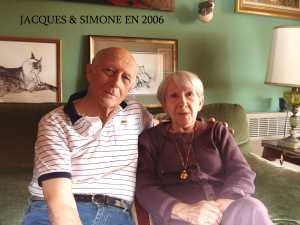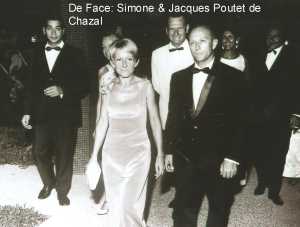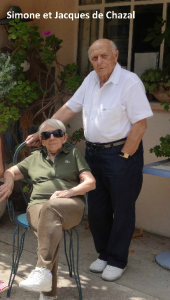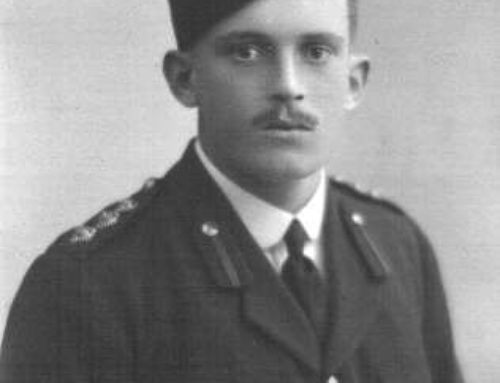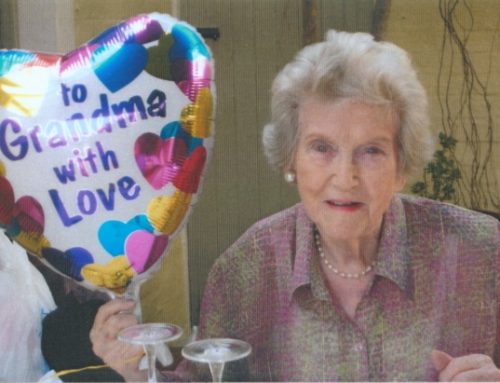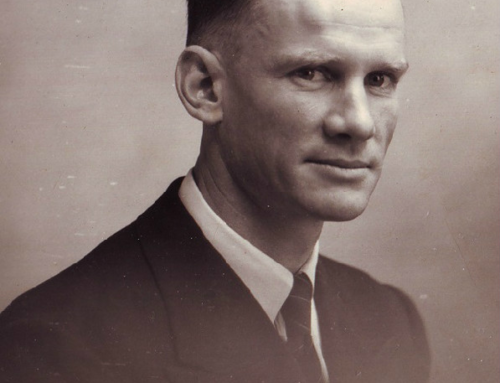French and English version
Jacques Poutet de Chazal
Souvenirs de Jacques Poutet de Chazal
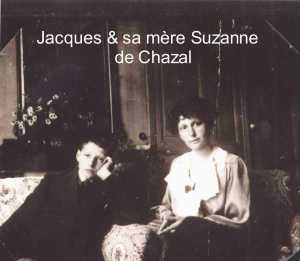
Jacques Poutet de Chazal est le fils de Suzanne de Chazal et petit fils d’Evenor de Chazal. Suzanne fut tuée tragiquement lors d’un bombardement le 13 août 1944 à Sanary
Île Maurice! C’est dans cette petite île merveilleuse de l’océan Indien (autrefois Ile de France) que Suzanne de Chazal, ma mère, est née en 1879 dans une des plus anciennes familles de cette terre lointaine. Francois de Chazal de la Geneste y émigra en 1760. Suzanne est sujet britannique puisque l’île est devenue anglaise en 1810, à l’issue de durs combats où la modeste garnison française dû capituler devant des forces très supérieures.
Suzanne est née le 24 janvier 1879 un mois avant la mort de son Grand-père Antoine Edmond fondateur, entre autres, d’un vaste domaine sucrier dénommé Saint-Antoine. Elle y vivra avec son père Evenor, sa mère et ses frères et soeurs jusqu’en 1888. Ils emménageront alors à Curepipe, 2 ieme ville de l’île après la capitale Port Louis, dans une belle demeure nouvellement construite: ” La Sablonniére” du nom d’un château du Loiret ayant appartenu à la famille. En 1896, à la suite de mauvaises affaires et de quelques ” désaccords”, Evenor emmène toute sa famille à Madagascar, dans la région de Fianaranrsoa. Il y redémarre une exploitation de canne à sucre en même temps que celle d’une concession aurifère. Mais il meurt 2 ans plus tard, à l’âge de 60 ans épuisé par une vie de travail et d’effort continus. Suzanne, ma mère épouse alors l’année suivante, en 1899, un ingénieur lyonnais Jean Lecomte dont son frère Chamarel avait fait le connaissance au cours d’un déplacement à Tananarive. Elle demeure sujet britannique tout en acquerrant la nationalité française. Ils vont s’installer à Lyon où ils auront 2 fils: Maurice en 1900 et Roger en 1904.
Le couple divorce vers 1915. C’est le guerre. Suzanne devient infirmière dans l’armée française, puis infirmière major à l’hôpital militaire d’Epinal. Des amis communs lui présentent un jeune lieutenant artilleur Jean Poutet avec qui elle vivra une importante histoire d’amour qui va se conclure par ma naissance le 7 juin 1920 à Toulon dans une jolie maison blanche sur les pentes du Mont Faron.
Peu nombreux sont les membres de notre famille avec qui nous sommes en relation. Je représente la “faute” impardonnable que ma pauvre et tendre You paiera toute sa vie. A cette époque barbizonnaise, je suis un petit garçon affectueux mais exclusif tout autant. Maman est “tout” pour moi et je n’imagine même pas que la moindre part de son coeur puisse aller à d’autres que moi-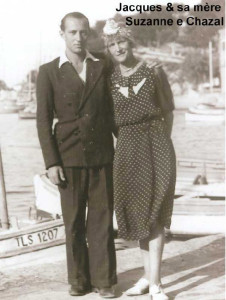 même et ceux du clan que je connais et dont j’approuve l’existence et l’amour partagé. Je n’aurais pas supporté qu’un intrus vint usurper la moindre place m’obligeant, nous obligeant à partager avec moi, avec vous le coeur de You. Elle le savait trop bien et j’admire aujourd’hui l’abnégation et sans doute l’habileté qu’elle a dû déployer pour que notre bonheur absolu ne connut la moindre égratignure.
même et ceux du clan que je connais et dont j’approuve l’existence et l’amour partagé. Je n’aurais pas supporté qu’un intrus vint usurper la moindre place m’obligeant, nous obligeant à partager avec moi, avec vous le coeur de You. Elle le savait trop bien et j’admire aujourd’hui l’abnégation et sans doute l’habileté qu’elle a dû déployer pour que notre bonheur absolu ne connut la moindre égratignure.
Le petit iceberg familial, détaché de la grande banquise de Chazal, qui avait conserve son affection et son intérêt à Suzanne, ma mère, tout en acceptant mon existence se réduisait au petit groupe suivant:
MARGUERITE: Elle était une soeur d’Evenor mon grand père, 13 ème des 15 enfants d’Edmond de Chazal et de Claire Rouillard. Tante Marguerite était en 1926 une “vieille dame” de 67 ans au beau visage rayonnant de bonté, parfois de malice, mais empreint à la fois d’une certaine tristesse dans son joli sourire.Elle avait épousé un officier français, Charles Tuffier, avec qui elle avait eu un fils unique Maurice Tuffier qui devait être tué a 22 ans alors jeune sous-lieutenant, le 30 août dans les durs combats des Ardennes. Beaucoup plus tard, lorsque Simone et moi avons perdu notre fils Olivier, je devais me rappeler et mieux comprendre le sourire triste de Tante Marguerite.
Elle habitait a Paris un bel appartement rue de Siam près de l’avenue Henri Martin dans le 16.eme, où elle nous accueillait volontiers avec sa grande et 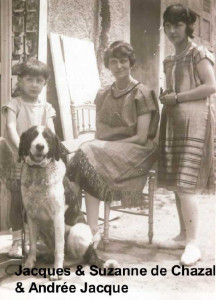 naturelle générosité. Elle aimait beaucoup You, fille de son frère aine, et moi aussi je crois, et nous nous lui rendions bien. Elle aimait venir avec nous se promener au Bois ou même aux Glaleries Lafayette, le grand magasin qu’elle préférait, mais où elle n’aimait pas trop s’aventurer seule.
naturelle générosité. Elle aimait beaucoup You, fille de son frère aine, et moi aussi je crois, et nous nous lui rendions bien. Elle aimait venir avec nous se promener au Bois ou même aux Glaleries Lafayette, le grand magasin qu’elle préférait, mais où elle n’aimait pas trop s’aventurer seule.
Bien plus tard, en novembre 1939, elle nous hébergea durant tout un mois, en attendant mon départ pour la base aérienne d’Avord ou je fus affecte comme élève pilote à la suite de mon engagement dès la déclaration de guerre en septembre. A mon retour d’Autriche fin mai 1945, je me rendis immédiatement rue de Siam, le Coeur plein de joie à l’idée de la revoir. Je fus très triste d’apprendre, par le concierge, sa mort survenue 2 ans plus tôt.
ADRIENNE: “Aunty Ada” était la soeur aînée de You. Je l’ai peu connue, l’ayant vu seulement 4 ou 5 fois entre 1923 et 1928. Je me souviens d’une personne, âgée me semblait-il. Elle avait 12 ans de plus que maman et devait donc pour moi être rangée naturellement parmi les vieux. Elle était très sourde et arborait  pour entendre -mal d’ailleurs- un grand cornet vers lequel il fallait se pencher pour lui parler. Elle avait cette voix aiguë et monocorde affectant certains sourds qui me mettait mal a l’aise- ce qui devait se traduire de ma part, par une mimique peu discrète et par trop expressive, assez peu courtoise en vérité . Elle et You s’en amusaient cependant, avec sans doute trop d’indulgence à mon égard. De aunty Ada je garde le souvenir d’une personne bonne et généreuse, pleine de tendresse et d’attention pour sa petite soeur Suzanne, ma mère. C’était pour moi la référence absolue.
pour entendre -mal d’ailleurs- un grand cornet vers lequel il fallait se pencher pour lui parler. Elle avait cette voix aiguë et monocorde affectant certains sourds qui me mettait mal a l’aise- ce qui devait se traduire de ma part, par une mimique peu discrète et par trop expressive, assez peu courtoise en vérité . Elle et You s’en amusaient cependant, avec sans doute trop d’indulgence à mon égard. De aunty Ada je garde le souvenir d’une personne bonne et généreuse, pleine de tendresse et d’attention pour sa petite soeur Suzanne, ma mère. C’était pour moi la référence absolue.
CHAMAREL: J’ai déjà dit toute l’admiration et l’affection que j’éprouvais à l’égard de l’oncle Cham, le frère peut-être préféré, mais surtout le plus proche de sa soeur Suzanne. J’aimais, lors de nos visites a Courbevoie, les écouter parler tous les deux de toutes sortes de questions, qui m’étaient le plus souvent inaccessibles. Mais, c’étaient généralement des conversations animées ou gaieté, sérieux, désaccords alternaient avec passion. Ils étaient tous deux très entiers dans leurs opinions, et leur très grande et mutuelle affection n’empêchait pas éventuellement quelques accrochages. Je me rappelle avec tristesse cette fin d’après-midi pluvieuse où un léger différend avait fini par dégénérer, sur quel sujet, je ne saurais le dire. Ils étaient ensuite aussi consternés l’un que l’autre, comme des enfants pris en faute, et lorsque à la tombée de la nuit il a fallu se séparer, ils se sont embrassés plus longuement, plus tendrement que d’habitude, avec un petit rire qui en disait long sur leur complicité. Ma jolie tante Hélène était quelque peu ignorée lors de ces bavardages à bride abattue. Ce n’était pas très délicat, sans doute, de la part de son mari et sa belle-soeur, mais ça ne semblait pas le moins du monde la contrarier. Ses rares interventions tombaient à plat dans un silence pouvant signifier que les choses sérieuses sont l’affaire des grandes personnes. Je crois en effet que la culture et la spiritualité n’étaient peut-être pas les qualités premières de tante Hélène. Elle me prenait alors par la main pour m’emmener vers des jeux qu’elle avait le don de savoir improviser. Nous nous entendions bien.Dans le grand salon où trônaient toujours 2 ou trios, voire quatre, postes de TSF, l’une des passions de l’Oncle Cham, de nombreux bibelots et tableaux de qualité marquaient l’intérêt et le goût de Cham pour l’Art en général. De Barbizon il avait ramené de belles toiles de Charles Jacque que Dany et le père Jacque lui avaient cédées à des conditions raisonnables. Il avait hésité concernant un joli Millet, de petites dimensions, rappelant un peu “les Glaneuses”. Il disait l’avoir regretté et il avait raison. Beaucoup parmi ces objets provenaient de Madagascar: des masques, des ivoires, diverses sculptures, et aussi de très belles gravures représentant des personnages, des animaux, des paysages. Mais c’est devant une belle grande pipe d’écume de mer que je tombais toujours en arrêt. Malgré toutes les explications qu’on avait tenté de me donner concernant ce très beau minéral tout à fait étranger à l’écume de la mer, je demeurais émerveillé par ce que je considérais comme un miracle de la nature. Ma passion pour cette pipe amusait Oncle Cham. Il m’expliqua qu’elle avait été acquise par son grand-père Edmond de Chazal qui l’avait placé dans son bureau à Saint-Antoine. A sa mort elle était revenue à son père Evenor et par la suite à lui-même Chamarel après la mort d’Evenor. Plus tard, maman devait être amenée à soigner Cham, souffrant d’un cancer de l’estomac, pendant 2 ou 3 mois jusqu’à sa mort. Tante Helene voulut alors lui laisser quelques souvenirs de son frère dont en particulier 2 ou 3 gravures malgaches et la pipe objet de mon admiration. Ce sont ces gravures (certaines disparues lors de nos nombreux déménagements) et cette pipe d’écume que j’ai pu récupérer, parmi de rares objets ayant appartenu à ma mere, lors de mon arrivée en France en octobre 44, dans des circonstances qui seront relatées plus loin.
YVONNE- Tante Yvonne était la dernière des 11 enfants d’Evenor. Née en 1890, elle avait donc 11 ans de moins que You. Elles étaient néanmoins très proches., puisque des 2 frères se situant entre elles dans la fratrie, l’un Ravenel avait choisi un mode vie qui l’avait malheureusement éloigné de sa famille, l’autre Guy s’était fixé très jeune en Amerique du Sud.. Yvonne était très vivante et gaie. Avec You elles avaient des bavardages sonores et savoureux ponctués de rires et d’éclats de voix qui amusaient tout l’entourage. Elle avait épousé un cousin germain Norman Mayer qui semble avoir eu une jeunesse quelque peu …. agitée, peut-être par la suite également, mais ceci est une autre histoire. Il était cependant Pasteur et semblait exercer son sacerdoce avec… conviction. Yvonne et Norman avaient 5 garçons (ils avaient perdu à un an une petite fille en 1926). Je ne connaissais que les trois premiers : l’ainé Paul (Polo), Jean (Jeannot) et Georges (Manu). Je ne sais comment il se fait que je n’aie jamais rencontré Jacques. Concernant Francis (Frank), ce n’est qu’en juillet 2002, à l’occasion d’une petite réunion de famille à Paris, que nous avons pu faire connaissance, hélas déjà quelque peu usés par 8 décennies et les épreuves essuyées au cours de ces longues années. Nous en reparlerons. J’aimais beaucoup me retrouver avec mes cousins, nous étions très remuants, trouvant toujours de nouvelles activités pas nécessairement appréciées des parents. Oncle Norman voulait afficher une certaine sévérité à notre égard, et il avait très certainement raison. Sa belle voix forte et grave m’impressionnait, mais je ne suis pas sûr qu’il ait possédé un réel talent de dresseur de garnements tels que nous. Il exigeait que nous arrivions à table dans une tenue impeccable, bien peignés et les mains propres. Nous estimions cette rigueur tout a fait juste et en arrivions même à rivaliser d’élégance. C’était donc positif. Par contre sa décision nous astreignant à 2 heures d’étude le soir avant le dîner tomba vite à l’eau. Notre mauvaise volonté, renforcée d’ailleurs par le peu d’enthousiasme de nos mères, l’amena à renoncer. Mais, ne voulant pas céder totalement, il prétendit consacrer ces 2 heures à la lecture et au commentaire d’un passage de la bible. Ce fut un très modeste succès qui ne dura en fait que deux ou trois séances. Cependant l’érudition de mon oncle était très réelle et j’étais sidéré de l’entendre répondre à toutes nos questions. You également, qui était d’une grande curiosité et toujours en quête d’enrichir ses connaissances, avait avec lui les mêmes entretiens passionnés qu’avec Oncle Cham. J’ etais très fier de constater que la culture de ma chère Maman était très estimable. Je sus par la suite que pendant les quelques 15 années vécues à Lyon, épouse de Jean Lecomte, elle avait continué des études interrompues à Madagascar, ceci expliquant cela. J’aimais beaucoup tante Yvonne, oncle Norman et mes trois cousins. Après la guerre je n’ai pas pu, pas su reprendre contact avec eux, ignorant ce qu’ils étaient devenus. Je suis encore plein de de regrets à ce sujet. De tante Yvonne je garde le souvenir d’une personne très “ mère poule” affichant au milieu de ses garçons et de son mari une béate sérénité que l’oncle Norman contemplait benoîtement. Il nous faudra faire revive tout cela avec Francis lors d’une prochaine rencontre. Mais quand ?
ENGLISH VERSION : Translation Christopher de Chazal
Jacques Poutet de Chazal is the son of Suzanne de Chazal and grandson of Evenor de Chazal. Suzanne was tragically killed in a bombing on August 13, 1944 in Sanary.
Mauritius! It is in this wonderful little island in the Indian Ocean (formerly Ile de France) that Suzanne de Chazal, my mother, was born in 1879 in one of the oldest families of this distant land. Francois de Chazal de la Geneste emigrated there in 1760. In 1810, after heavy fighting when the modest French garrison had to capitulate to far superior English forces the island became a British Colony, hence Suzanne was a British subject. Suzanne was born on January 24, 1879, a month before the death of her grandfather Antoine Edmond, founder, among other things, of a vast sugar estate called Saint-Antoine. She lived there with her father Evenor, her mother and her brothers and sisters until 1888. They then moved to Curepipe, the island’s second largest city after the capital Port Louis; to a beautiful newly built house: “La Sablonniére” named after a Loiret castle that belonged to the family. In 1896, following poor business decisions and some “disagreements”, Evenor took his whole family to Madagascar, to the Fianaranrsoa region. He restarted a sugar cane operation at the same time as that of a gold concession. But he died two years later, at the age of 60 exhausted by a life of continuous work and effort. Suzanne, my mother was married the following year, in 1899, to a Lyon engineer, Jean Lecomte whom her brother Chamarel had met during a trip to Tananarive. She remained a British subject while acquiring French citizenship. They moved to Lyon where they had two sons: Maurice in 1900 and Roger in 1904.
The couple divorced in about 1925. The war was on. Suzanne became a nurse in the French Army, then in a major Military Hospital in Epinal. Mutual friends introduced her to an artillery lieutenant, Jean Poutet, with whom she had a loving relationship which would conclude with my birth on 7th June 1920 in Toulon, in a pretty white house on the slopes of Mount Faron.
There are very few of the family with whom we kept contact. I represent the unpardonable “fault” that my poor and tender ‘You’ would have to suffer for the rest of her days. In these days when we lived in Barbizon I was an affectionate although an only child. Mother was my all and I could not imagine that the smallest part of her heart could be anyone else’s but mine; to be shared only with those of the immediate circle that I knew and approved of. I would never have put up with an intruder usurping the place I held; obliging me to share You’s love with another. She knew this only too well and to this day I admire the sacrifices, and without doubt the subterfuge and strength of character, she had to deploy so that there should not be the slightest blight or impairment to our happiness.
The small family unit, detached from the huge de Chazal family, which had kept its love for, and interest in, Suzanne my mother, while also accepting my presence, was reduced to the following small group:
MARGUERITE: she was a sister of Evenor, my Grandfather, 13th of the 15 children of Edmond de Chazal and Claire Rouillard. Aunt Marguerite in 1926 an “old woman” of 67 years with a fine face radiating goodness, sometimes mischievousness, but her pretty smile was tinged with a certain sadness. She had married a French Officer, Charles Tuffier, with whom she had an only son, Maurice, a sub-lieutenant, who was killed on 30th August aged 22, during the hard fought battles of the Ardennes. Much later when Simone and I lost our son Oliver, I was to remember this and understood better that sad smile of Aunt Marguerite.
She lived in Paris in a grand apartment in the Rue de Siam near the Avenue Henri Martin in the 16th District. She would happily greet us with natural and boundless generosity. She loved You, daughter of her eldest brother, and I think she loved me too, and we reciprocated that love. She enjoyed coming with us to The Bois de Boulogne and even to the Galleries Lafayette, her favourite store, where she was reluctant to go on her own.
Very much later, in November 1939, she put us up for a month while I was waiting for my departure to the Avord Airbase where, following my call-up as soon as war was declared in September, I would become a trainee pilot. On my return from Austria at the end of May 1945 I went immediately to the Rue de Siam, with heart full of joy at the idea of seeing her once again; I was very sorry to hear from the concierge of her death two years previously.
ADRIENNE: “Aunty Ada” was You’s elder sister. I did not know her well, having seen her only four or five times between 1923 and 1928. I remember what seemed to me to be an elderly person. She was twelve years older than mother and quite naturally I considered her to be old. She was very deaf and held a big horn to her ear towards which one had to lean to speak to her. She had that shrill monotone voice which some deaf people have, that made me uncomfortable. Sometimes I indiscreetly copied her rather too loudly; in truth not very nice of me. You and she nevertheless got on well, too much so perhaps, undoubtedly with too much indulgence to my regard. I think of Aunty Ada as a good and generous person, full of tenderness and regard for her little sister Suzanne, my mother. For me that was the most important thing.
CHAMAREL: I have already told of the admiration and love that I had towards my Uncle Cham, perhaps the favourite brother, but above all, the closest to his sister Suzanne. When visiting Courbevoie I loved to hear them both speak on all sorts of subjects, more often than not, those which were beyond me. However, the conversations were generally lively and happy or serious and argumentative delivered with passion. Both of them held strong opinions and their great mutual affection did not sometimes stop them from disagreeing. I remember with sadness the end of a rainy day when a slight difference got out of hand, on what subject I am unable to say. They were both upset one as much as the other, as children who have done something wrong; and as night fell and they had to part, they kissed and held each other longer and more tenderly than was usual, with a little laugh which said more than words could say about their closeness. My dear Aunt Hélène was rather left out during these lively exchanges. This was, without doubt, not very sensitive of her husband and her sister-in-law, but it did not seem to worry her in the least. Her rare contributions fell flat, into a silence indicating that serious things concerned only important people. I believe that culture and spirituality were not the most important concerns of Aunt Hélène. She took my by the hand to lead me toward improvised games for which she had a gift. We understood each other well. In the main drawing-room there were always two or three and sometimes four radios (TSF) taking pride of place, one of the hobbies of Uncle Cham: many bookshelves and good quality paintings showed off Cham’s interest in Literature and Art in general. From Barbizon (a town near Fontainbleau) he had brought back some lovely canvasses by Charles Jacque that Dany and father Jacques had allowed him to have at a reasonable price. He had hesitated in respect of a beautiful Millet, of small dimensions, reminding one a little of “The Gleaners”. He said, with some reason, that he regretted not buying it. Many of these objects came from Madagascar: masks, ivories, several sculptures, also some very good drawings representing well known people, animals and landscapes. However, I was always brought to a standstill in front of a huge, well carved “Sea-spume” (a mineral known as meerschaum) pipe. Despite all the explanations that they tried to give me concerning this wonderful mineral, completely alien to sea-spume, I was always amazed by what I considered to be a miracle of nature. Uncle Cham was amused by my obsession with this pipe. He told me that it had been acquired by his Grandfather Edmond de Chazal who had displayed it in his office at Saint Antoine. On his death it had passed to his father and then to Chamarel himself after the death of Evenor. Later, mother must have been summond to look after Cham, who had cancer of the stomach, for a month or two before his death. Aunt Helene wanted to give her a few things in remembrance of her brother and in particular two or three Malgash pictures and the pipe, the object of my admiration. It is these few pictures, (apart from some that disappeared in our frequent moves) and the meerschaum pipe, that I managed to recover from the very few possessions belonging to my mother when I arrived in France in October 1944, in circumstances I will detail later.
YVONNE– Aunt Yvonne was the last of the eleven children of Evenor. Born in 1890, she was therefore eleven years younger than You. They were nevertheless very close, since there were two brothers between them in the family hierarchy. One of them, Ravenel, chose a lifestyle which unfortunately alienated him from the family; the other, Guy, went at a young age to settle in South America. Yvonne was lively and gay. With You they chatted away in loud voices with busts of laugher which made everyone happy. She had married a first cousin Norman Mayer who seems to have had a childhood a little….disturbed, perhaps even more than that, but that is another story. He was at the time a Minister and seemed to carry out his sacred duties with….conviction. Yvonne and Norman had five boys (they had lost a one year old daughter in 1926). I only knew the first three: the eldest Paul (Polo), Jean (Jeannot) and Georges (Manu). I have no idea why I never met Jacques. About Francis (Frank), it was only in July 2002 at a small family reunion in Paris that we got to know each other; alas, somewhat worn down after eight decades of tribulation and long years. We will come back to him. I loved to be with my cousins, we were very disruptive, always finding new things to do, not necessarily appreciated by our parents. Uncle Norman wanted to subject us to a certain discipline, and he certainly had good reason. His sonorous and strong voice impressed me but I am not sure that he had any talent in subjecting discipline to little scamps, as we were. He insisted that we came to table impeccably dressed, well combed and with clean hands. We found this measure completely just and even came to vie with each other in elegance; it was therefore a positive influence. On the other hand his orders forcing us to do two hours of study in the evenings before dinner fell on deaf ears. Our bad grace, reinforced by the lack of support by our mothers, led him to give in. However, not willing to give up totally, he maintained setting aside these two hours for sermonizing and commentary on a passage in the Bible. This was a modest success that only lasted for two or three sessions. However the erudition of my uncle was very real and I was astounded to hear him reply to all our questions. You, having a great thirst for knowledge, had the same passionate discussions with him as she had with Uncle Cham. I was very proud to see that my dear mother’s cultural accomplishments were up to the task. Later I understood; for the fifteen or so years while living in Lyon, as the wife of Jean Lecomte, she took up her studies that had been interrupted in Madagascar, and that explains it. I loved Aunt Yvonne, Uncle Norman and my three cousins very much. After the war I was unable, or did not know how to make contact with them once more, not knowing what had become of them. I am still full of regrets about this. Of Aunt Yvonne I have fond memories of a “mother hen” character sitting serenely amongst her boys with her husband Uncle Norman looking upon them benevolently. We should make all this come to life once more with Francis at another meeting, but when?

